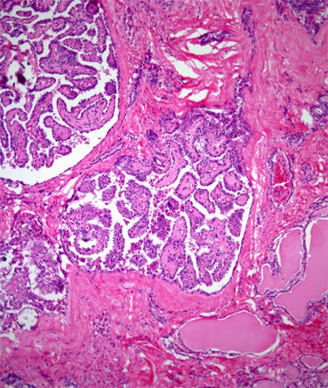Marker in Thyroid Cancer Can Help Reclassify Patients as Low Risk
Papillary thyroid cancer patients at intermediate risk according to guidelines can be reclassified as low risk when postoperative stimulated thyroglobulin is low.
Low power view of a papillary thyroid carcinoma.

Patients with papillary thyroid cancer (PTC) at intermediate risk according to guidelines can be reclassified as low risk when postoperative stimulated thyroglobulin (sTg) is low, according to a new study.
Based on previous work, patients with very high Tg but without findings on post-therapy whole-body scanning are considered to be at high risk of recurrence. “If a very high Tg defines a high risk of recurrence, it is reasonable to hypothesize that, at the other extreme, a low Tg (in the absence of anti-Tg antibodies) could reclassify patients from intermediate to low risk,” wrote study authors led by Pedro Weslley Rosario, MD, of the Instituto de Ensino e Pesquisa da Santa Casa in Belo Horizonte, Brazil.
Previously, reclassification had only been evaluated 1 to 2 years after radioiodine therapy; the current study evaluated reclassification at the point of initial therapy. The results were published online ahead of print in Thyroid.
The study included a total of 181 patients with PTC who underwent total thyroidectomy with lymph node dissection, without persistent tumor after surgery, a postoperative sTg of no more than 2 ng/mL and negative anti-Tg antibodies. All patients were considered to be at intermediate risk for recurrence based on American Thyroid Association guidelines.
At evaluations conducted 9 to 12 months following radioiodine therapy, 170 patients (94%) had a sTg < 1 ng/mL and negative antibodies, as well as a negative neck ultrasound. Ten patients (5.5%) had an sTg of greater than 1 ng/mL (≤ 2 ng/mL) in the absence of disease based on imaging results, and one had cervical lymph node metastases detected with ultrasound.
Of the 180 patients with no disease on that initial assessment, 5 recurred (2.7%) during a median 60-month follow-up period, meaning recurrent or persistent disease occurred in 3.3% of cases. None of the 175 patients with no recurrence or persistent disease received any additional therapy, and all had a Tg level below 1 ng/mL at their final assessment.
“In the same way patients with a very high postoperative Tg are considered to be high risk, the results of the present study suggest that patients at intermediate risk can be reclassified as low risk already at the time of initial therapy when the postoperative sTg is ≤ 2 ng/mL,” the authors concluded.
Newsletter
Stay up to date on recent advances in the multidisciplinary approach to cancer.